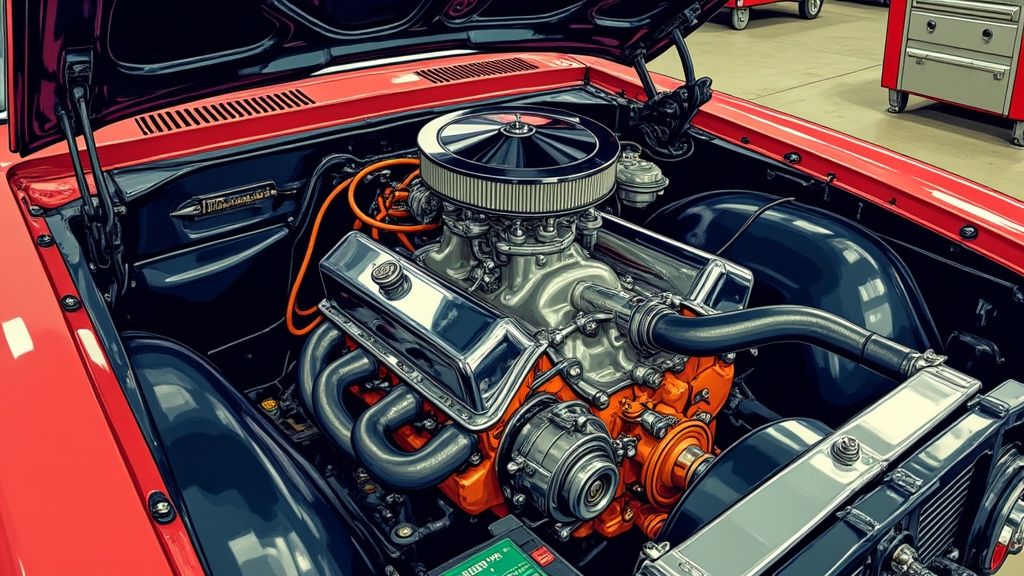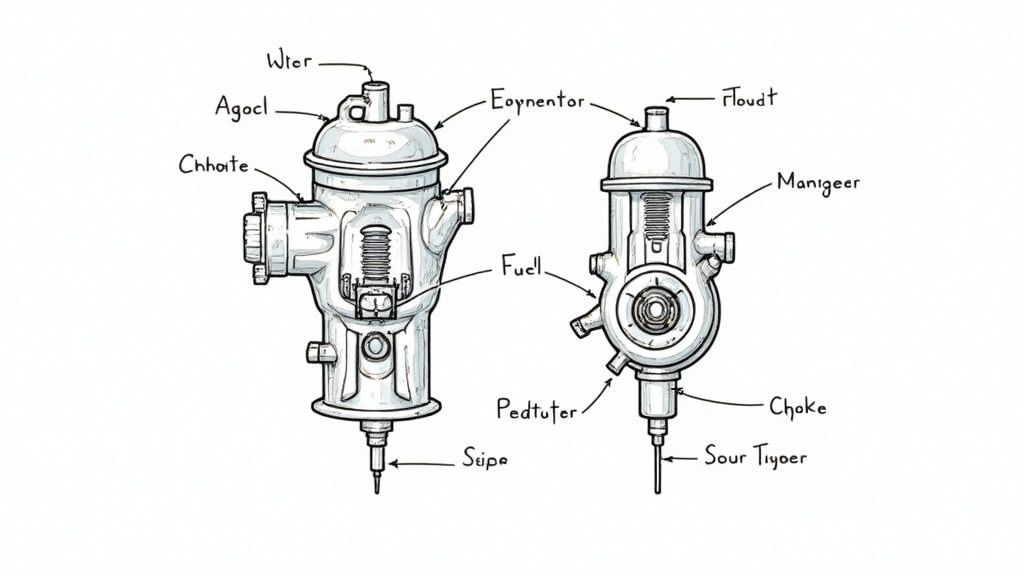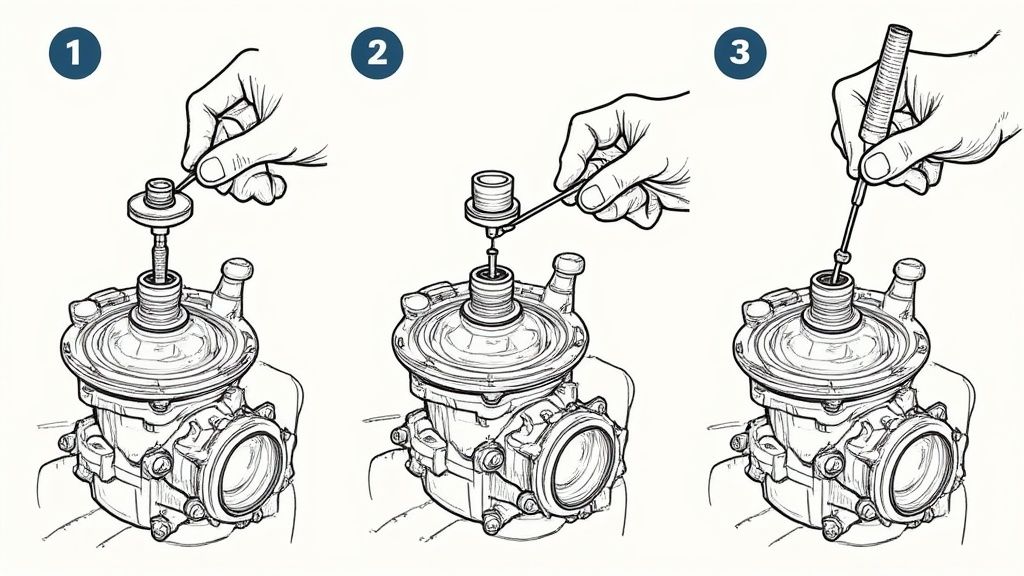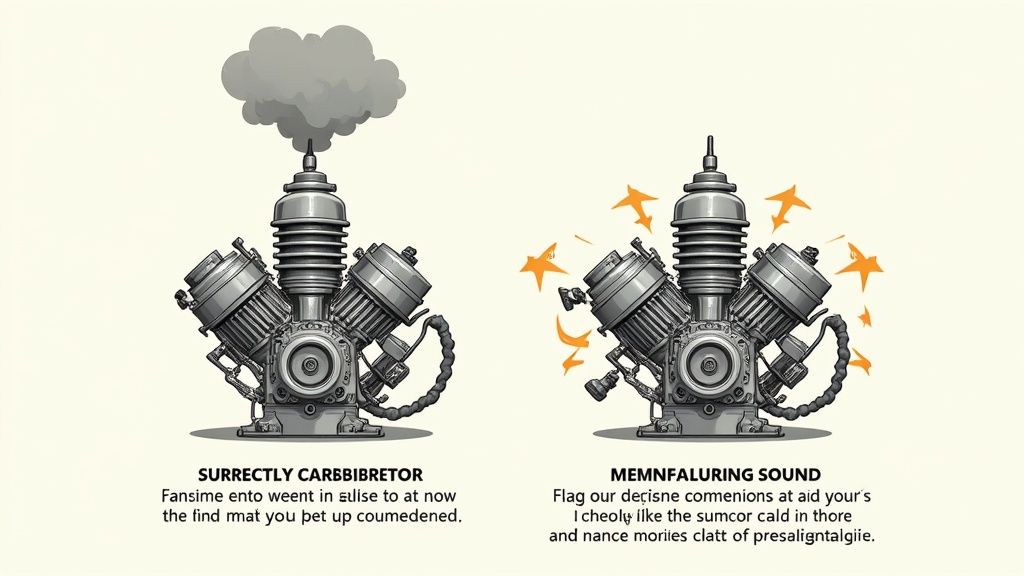
How to Tune Carburetors for Superior Engine Performance
Mastering Carburetor Fundamentals

A carburetor is a precision-engineered device that mixes air and fuel in the right proportions for your engine. When properly tuned, it helps achieve optimal performance, fuel efficiency, and engine longevity. Learning the basics of how carburetors work is essential for anyone wanting to maintain or modify their engine.
The Venturi Effect: The Heart of Carburetor Operation
The venturi is a narrow passage inside the carburetor that creates the air-fuel mixture. When air flows through this constricted area, its speed increases while pressure drops. This pressure difference pulls fuel from the fuel bowl and mixes it with the passing air - similar to how a perfume atomizer works. This basic principle, called the Venturi effect, is what makes carburetors function.
Core Components and Their Roles
Several key parts work together to make a carburetor operate smoothly:
- The throttle valve manages airflow to control engine speed
- The float and needle valve maintain proper fuel levels
- Jets carefully meter fuel flow for the right mixture
- The accelerator pump adds extra fuel during quick acceleration
Carburetors have proven their worth over 120 years of automotive history, with the first float-style designs appearing in the late 1800s. During acceleration, they adjust to provide a richer 9:1 air-fuel ratio. Learn more about carburetor history and operation here.
Recognizing the Signs of a Troubled Carburetor
Common signs that indicate your carburetor needs attention include:
- Rough or unstable idle
- Poor gas mileage
- Hesitation when accelerating
- Black exhaust smoke
Being able to spot these warning signs helps you address issues before they become major problems. Understanding these carburetor basics will make you better equipped to diagnose and fix performance issues. Next, we’ll look at the tools and workshop setup needed for proper carburetor tuning.
Essential Tools and Workshop Setup

A properly equipped workspace with the right tools is essential for safe and accurate carburetor tuning. Just like any precision work, having quality tools and an organized setup makes the difference between frustration and success.
Must-Have Tools for Carburetor Tuning
Here are the essential tools you’ll need to properly tune your carburetor:
Essential Carburetor Tuning Tools
| Tool Name | Purpose | Estimated Cost | Skill Level Required |
|---|---|---|---|
| Vacuum Gauge | Synchronizing carburetors and setting idle mixtures | $30-100 | Intermediate |
| Tachometer | Measuring engine RPM for idle adjustments | $25-75 | Beginner |
| Screwdriver Set | Accessing and adjusting carburetor components | $20-50 | Beginner |
| Carb Cleaning Kit | Removing deposits and buildup | $15-40 | Beginner |
| Spark Plug Tools | Inspecting and changing spark plugs | $10-30 | Beginner |
Having these basic tools ready before you start will help you work efficiently and get accurate results.
Creating an Efficient and Safe Workspace
Your work area needs three key elements for safe and effective carburetor tuning:
-
Good Ventilation: Always work in a well-ventilated space when using carburetor cleaners and solvents. Fresh air flow prevents dangerous fume buildup.
-
Proper Lighting: Bright, focused lighting helps you see small parts and make precise adjustments. Use both overhead and task lighting.
-
Clean Organization: Keep tools neatly arranged and within easy reach. A clutter-free workspace prevents lost parts and makes the job smoother.
Understanding Carburetor Components and Their Functions
Successful tuning requires understanding how carburetor parts work together. Key components like jets, air bleeds, and venturis all affect the air-fuel mixture. Manufacturers like Holley jet their carburetors differently for street versus racing use. The factory settings are based on careful testing. Learn more about carburetor theory here. This knowledge helps you make smart tuning decisions.
The Perfect Tune: Step-by-Step Process

Tuning carburetors requires patience and attention to detail. With the right tools and preparation, let’s explore how to properly tune your carburetor step by step.
Initial Setup and Baseline Adjustments
Start by warming up your engine to normal operating temperature. Turn both idle mixture screws clockwise until they gently seat, being careful not to overtighten. Back each screw out 1.5 turns to create your baseline idle mixture setting. Using the idle speed screw on the throttle linkage, adjust the idle speed to match manufacturer specifications.
Fine-Tuning the Idle Circuit
Listen carefully to the engine with it running - you want a steady, consistent idle. If it stalls, increase the idle speed slightly. Make tiny 1/4 turn adjustments to the idle mixture screws one at a time, listening for the smoothest idle. If these adjustments don’t help, check for vacuum leaks, which are common on older engines like the Ford 292. Learn more about engine tuning fundamentals.
Optimizing the Mixture and Accelerator Pump
After setting the idle, focus on the fuel mixture across different engine speeds. Make small tweaks to the main jets and air bleeds, watching how the engine responds during test drives. Pay attention to the accelerator pump which provides extra fuel when accelerating. Getting the pump’s stroke and timing right ensures smooth throttle response.
Troubleshooting Common Tuning Issues
Watch for these typical problems and solutions:
- Rough Idle: Check idle mixture, vacuum leaks, and idle circuit for clogs
- Hesitation: Usually related to accelerator pump or lean mixture
- Backfiring: Often caused by lean mixture or ignition timing
- High Fuel Use: Rich mixture is common - try smaller jets or adjust float
Final Adjustments and Verification
Take the vehicle for a test drive to check performance at different speeds and loads. A properly tuned carburetor provides smooth acceleration and good fuel economy. Use a vacuum gauge and tachometer to verify your settings. Document all adjustments and results in Auto Service Logger to track changes and maintain records for future reference.
Professional Tuning Techniques Revealed

This section covers advanced carburetor tuning methods that will help you maximize performance across different operating conditions. Understanding how each component affects engine output is key to achieving optimal results.
Let’s first look at typical air-fuel requirements for different scenarios:
| Operating Condition | Ideal Air-Fuel Ratio | Symptoms of Incorrect Mixture |
|---|---|---|
| Idle | 14.7:1 | Rough idle, stalling |
| Light Cruise | 15:1 | Poor fuel economy, hesitation |
| Full Power | 12.5:1 | Loss of power, overheating |
| Cold Start | 12:1 | Hard starting, poor warm-up |
Power Valve Selection and Tuning
The power valve adds extra fuel under high engine loads to prevent knock and maximize power output. Choosing the right power valve rating depends on your engine’s vacuum at wide-open throttle. Too high a rating causes rich running at higher RPMs, while too low causes premature activation and wasted fuel. For background on how power valves developed, check out the history of carburetor technology.
Jet Sizing Mathematics: Finding the Right Balance
Jet sizing calculations help match fuel flow to engine demands. Consider these key factors:
- Engine displacement
- Compression ratio
- Intended use (street vs race)
- Operating altitude
- Typical temperatures
The goal is finding the sweet spot where the engine gets exactly the fuel it needs across the RPM range.
Specialized Adjustments for Different Applications
Daily drivers need different tuning than race engines. Street cars prioritize smooth running and good fuel economy, using smaller jets and mild power valve settings. Race engines focus on maximum power, requiring larger jets, aggressive power valves, and precise tuning of every component.
Environmental Factors: Adapting Your Tuning Strategy
Altitude and temperature significantly impact carburetor tuning. Higher elevations need leaner mixtures due to thinner air. Temperature changes affect fuel density and vaporization - cold air is denser and needs more fuel. Making these adjustments ensures consistent performance in any conditions.
Evolution of Carburetor Technology
The art of carburetor tuning reveals an extensive history of mechanical development. Understanding how carburetors evolved helps explain modern tuning methods and shows why certain designs still excel for specific uses, even as fuel injection dominates.
Early Innovations and the Rise of the SU Carburetor
The early 1900s brought major advances in carburetor design. A key breakthrough was the SU carburetor with its variable-venturi system, which improved fuel delivery compared to fixed-venturi models. Many core tuning principles from this era remain relevant today. The impact of World War I on carburetor manufacturing provides interesting context - in 1914, factories switched to making war supplies, dramatically reducing carburetor production. Learn more about the history of SU carburetors.
How Historical Developments Shape Modern Tuning
The early carburetor innovations created lasting design principles still used in current models. The accelerator pump, created to prevent hesitation during quick throttle changes, remains essential in modern carburetors. Better materials and production methods have also steadily improved carburetor durability and reliability over time.
Classic Features That Still Excel Today
While technology keeps advancing, some traditional carburetor features offer unique benefits. The straightforward mechanical connections often work better than complex electronic systems when it comes to reliability and easy maintenance. This makes them ideal for classic car restoration and off-road vehicles where simplicity and toughness matter most.
Using Historical Knowledge for Better Tuning
Knowing how carburetors developed helps tuners understand the unique aspects of different designs. This knowledge proves especially valuable when working on vintage vehicles or special applications. For example, recognizing the limitations of early fixed-venturi designs helps inform decisions about fuel mixture and throttle response. Taking this historical view leads to smarter tuning choices that improve both performance and efficiency.
Maintenance Mastery and Problem Solving
Learning proper carburetor maintenance and diagnostic skills helps prevent minor issues from becoming major repairs. By developing a thorough understanding of carburetor tuning and troubleshooting, you can keep your engine performing reliably for years to come.
Preventative Maintenance: A Proactive Approach
Regular upkeep is essential for carburetor health, much like changing your engine oil. Consistent maintenance prevents expensive repairs down the road.
- Regular Cleaning: A clean carburetor is crucial for optimal performance. Use a quality cleaning kit to remove gum and varnish deposits that can block fuel passages.
- Inspect Components: Check gaskets, diaphragms, and floats for signs of wear. Small problems can quickly affect engine performance if ignored.
- Fuel Filter Replacement: Install fresh fuel filters according to your maintenance schedule to keep dirt out of the carburetor. Replace more frequently if you drive in dusty conditions.
Good maintenance habits improve fuel economy and engine performance while extending carburetor life.
Troubleshooting Framework: A Systematic Approach
Problems can occur even with careful maintenance. Following a clear diagnostic process helps pinpoint and fix issues quickly.
- Identify Symptoms: Start by noting specific issues like rough idling or hesitation during acceleration. For example, a rough idle could indicate a vacuum leak, as shown in this article about a Ford 292 engine here.
- Find the Cause: Check common problem areas like vacuum leaks, clogged jets, or accelerator pump issues. Use diagnostic tools like vacuum gauges and tachometers.
- Fix the Problem: Once you’ve found the cause, make needed repairs or adjustments. This might involve cleaning parts, adjusting settings, or getting professional help for complex issues.
A systematic approach to troubleshooting saves time and frustration in diagnosing carburetor problems.
Expert Diagnostic Techniques: Recognizing the Warning Signs
Learning to spot early warning signs allows you to address carburetor issues before they worsen.
- Rough Idling: An uneven or unstable idle may signal vacuum leaks, incorrect mixture settings, or clogged idle circuits.
- Hesitation or Stalling: Problems accelerating often point to accelerator pump issues or lean fuel mixtures.
- Poor Fuel Economy: Sudden drops in MPG suggest a rich mixture from oversized jets, choke problems, or incorrect float settings.
- Black Exhaust: Dark exhaust smoke indicates excessive fuel consumption that can lead to fouled spark plugs.
Catching these symptoms early prevents more serious engine damage and keeps your carburetor working properly.
Ready to track your maintenance history? Auto Service Logger offers a secure way to record all your vehicle care, from oil changes to carburetor adjustments. Get lifetime access today at Auto Service Logger.